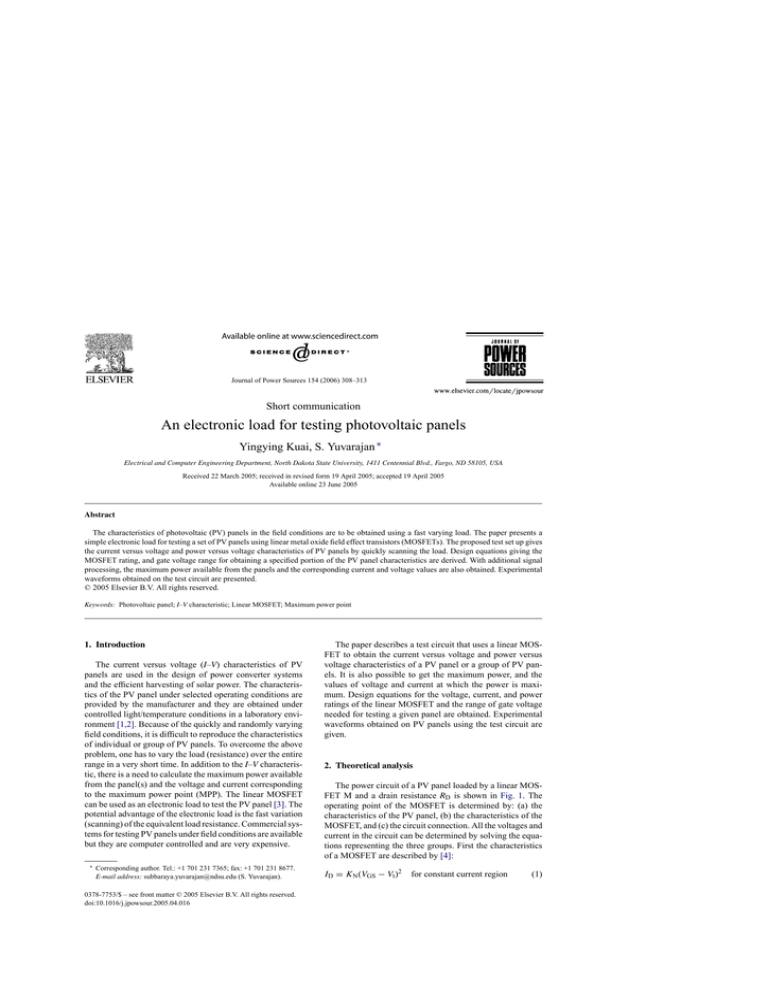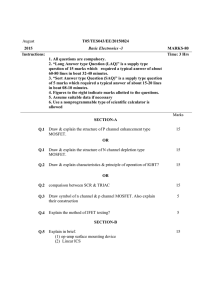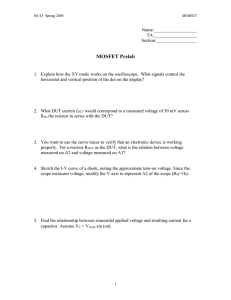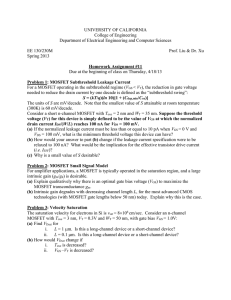
Journal of Power Sources 154 (2006) 308–313
Short communication
An electronic load for testing photovoltaic panels
Yingying Kuai, S. Yuvarajan ∗
Electrical and Computer Engineering Department, North Dakota State University, 1411 Centennial Blvd., Fargo, ND 58105, USA
Received 22 March 2005; received in revised form 19 April 2005; accepted 19 April 2005
Available online 23 June 2005
Abstract
The characteristics of photovoltaic (PV) panels in the field conditions are to be obtained using a fast varying load. The paper presents a
simple electronic load for testing a set of PV panels using linear metal oxide field effect transistors (MOSFETs). The proposed test set up gives
the current versus voltage and power versus voltage characteristics of PV panels by quickly scanning the load. Design equations giving the
MOSFET rating, and gate voltage range for obtaining a specified portion of the PV panel characteristics are derived. With additional signal
processing, the maximum power available from the panels and the corresponding current and voltage values are also obtained. Experimental
waveforms obtained on the test circuit are presented.
© 2005 Elsevier B.V. All rights reserved.
Keywords: Photovoltaic panel; I–V characteristic; Linear MOSFET; Maximum power point
1. Introduction
The current versus voltage (I–V) characteristics of PV
panels are used in the design of power converter systems
and the efficient harvesting of solar power. The characteristics of the PV panel under selected operating conditions are
provided by the manufacturer and they are obtained under
controlled light/temperature conditions in a laboratory environment [1,2]. Because of the quickly and randomly varying
field conditions, it is difficult to reproduce the characteristics
of individual or group of PV panels. To overcome the above
problem, one has to vary the load (resistance) over the entire
range in a very short time. In addition to the I–V characteristic, there is a need to calculate the maximum power available
from the panel(s) and the voltage and current corresponding
to the maximum power point (MPP). The linear MOSFET
can be used as an electronic load to test the PV panel [3]. The
potential advantage of the electronic load is the fast variation
(scanning) of the equivalent load resistance. Commercial systems for testing PV panels under field conditions are available
but they are computer controlled and are very expensive.
∗
Corresponding author. Tel.: +1 701 231 7365; fax: +1 701 231 8677.
E-mail address: subbaraya.yuvarajan@ndsu.edu (S. Yuvarajan).
0378-7753/$ – see front matter © 2005 Elsevier B.V. All rights reserved.
doi:10.1016/j.jpowsour.2005.04.016
The paper describes a test circuit that uses a linear MOSFET to obtain the current versus voltage and power versus
voltage characteristics of a PV panel or a group of PV panels. It is also possible to get the maximum power, and the
values of voltage and current at which the power is maximum. Design equations for the voltage, current, and power
ratings of the linear MOSFET and the range of gate voltage
needed for testing a given panel are obtained. Experimental
waveforms obtained on PV panels using the test circuit are
given.
2. Theoretical analysis
The power circuit of a PV panel loaded by a linear MOSFET M and a drain resistance RD is shown in Fig. 1. The
operating point of the MOSFET is determined by: (a) the
characteristics of the PV panel, (b) the characteristics of the
MOSFET, and (c) the circuit connection. All the voltages and
current in the circuit can be determined by solving the equations representing the three groups. First the characteristics
of a MOSFET are described by [4]:
ID = KN (VGS − Vt )2
for constant current region
(1)
Y. Kuai, S. Yuvarajan / Journal of Power Sources 154 (2006) 308–313
309
found in [5]. The following equation can be written for the
circuit:
VPV = VDS + ID RD
Fig. 1. Basic power circuit.
2
ID = KN (2(VGS − Vt )VDS − VDS
)
for ohmic region
(2)
where KN is the device constant, Vt the threshold (gate)
voltage, VGS the gate-source voltage, VDS the drain-source
voltage, and ID the drain current of the MOSFET. The approximate equation for a PV panel can be written as
ID = IPV = ISC − IS eKVPV
(3)
where VPV is the voltage across the PV panel, IPV the output
current of the PV panel which is equal to ID , ISC the shortcircuit current, IS the dark-saturation current of the PV panel
and K is a constant which depends on the temperature and
cell arrangement in the panel [5]. The series resistance of the
panel RS is neglected in Eq. (3) and the exact equation can be
(4)
When the MOSFET is working in the constant current region
((VGS − Vt ) < VDS ), Eqs. (1), (3) and (4) hold. When the
MOSFET is working in the ohmic region ((VGS − Vt ) > VDS ),
Eqs. (2)–(4) hold. If the PV characteristic, the MOSFET characteristics and RD are all given, the operating point of the
MOSFET is determined by the value of VGS . By sweeping
VGS in the appropriate range, the operating point of the MOSFET can be changed, which also drives the operating point
of the PV panel to move along its I–V characteristic curve.
This process is illustrated in Fig. 2 which shows the load
curves (nonlinear) for the MOSFET drawn for different values of RD and the characteristics of the MOSFET. The load
curve is obtained by combining Eqs. (3) and (4). While VGS
varies from VGS1 to VGS2 , the operating point of the MOSFET moves from Q1 to Q2 , hence the characteristic of the PV
panel between Q1 (I1 ) and Q2 (I2 ) is traced.
It should be noted that ISC is equal to IPV (or ID ) when
VPV = 0 and not when VDS = 0. The value of ID when VDS = 0
is denoted as IPVL , which is lower than ISC . When RD = 0, the
load curve becomes the I–V characteristic of the PV panel
with VPV = VDS , and IPVL approaches ISC . After locating the
operating point, say Q2 , the value of VPV is obtained by drawing a straight line with a slope −1/RD1 through Q2 as shown
in Fig. 2. The point at which this line intersects the X-axis is
VPV .
Fig. 2. MOSFET characteristics and load curves.
Y. Kuai, S. Yuvarajan / Journal of Power Sources 154 (2006) 308–313
310
When VGS is increased from 0 V, the MOSFET will stay
OFF until VGS exceeds the threshold voltage Vt . After that,
the MOSFET will enter the constant current region and continue to work in that region until it reaches a point where
VGS = VGSL which is equal to VDS + Vt . The corresponding
value of ID is denoted as IDL . The values of VGSL and IDL are
obtained by solving Eqs. (5) and (6) which are obtained by
substituting VGS = VGSL in Eqs. (1) and (3) as
2
IDL = KN VGSL
(5)
IDL = ISC − IS eK(VGSL −Vt +IDL RD )
(6)
For a given RD , the maximum power dissipated by the MOSFET while loading the PV panel should be smaller than its
power rating. If PM is the power dissipated by the MOSFET
at any operating point with a given value of RD and PPV the
power supplied by the PV panel, then we have:
PM = PPV − ID2 RD
(7)
Then PM can be expressed as
PM =
2.1. IPVMAX and VPVMIN
2
IPV VPV − IPV
RD
(8)
Substituting for IPV from (3) in (8), we get
2
PM = −RD ISC
+ ISC VPV + IS (2RD ISC − VPV ) eKVPV
− RD IS2 e2KVPV
(9)
The derivative of PM with respect to VPV is given by
PM
= ISC + IS (2KRD ISC − 1 − KVPV ) eKVPV
− 2KRD IS2 e2KVPV
the MOSFET can also be calculated. A higher value of RD
reduces the power dissipated by the MOSFET but this will
limit the range of PV characteristic that can be covered by the
electronic load. After the value of RD is determined, we need
to choose the range of VGS that can cover a selected (significant) portion of the PV panel characteristic. The variation of
the power supplied by the PV panel and the ones dissipated by
the MOSFET and the resistance RD are shown in Fig. 3. For
a given RD , the lower limits on VPV and IPV are also shown
in the figure. Including the series resistance of the PV panel,
the output power will be slightly less and the power rating of
the MOSFET to be used will also be correspondingly lower.
The relationships between (a) the maximum gate voltage VGSMAX and the corresponding panel current IPV (ID )
(maximum) and panel voltage VPV (minimum) and (b) the
minimum gate voltage VGSMIN and the corresponding panel
current IPV (ID ) (minimum) and the panel voltage VPV (maximum) can be obtained as follows.
(10)
= 0 when P is maximum (equal to P
PM
M
MMAX ). Equating
(10) to zero and solving for VPV and substituting back in (9),
we get the maximum power that will be dissipated by the
MOSFET for a given RD . Using the same process, the value
of RD that has to be used to provide enough protection for
If VGSMAX < VGSL , IPVMAX will occur in the constant current region of the MOSFET which gives:
IPVMAX = KN (VGSMAX − Vt )2
2
ISC − KN IPVMAX
1
VPVMIN = ln
K
IS
(11)
(12)
Given VGSMAX , the value of IPVMAX can be calculated from
(11) and that of VPVMIN is calculated from (12).
If VGSMAX ≥ VGSL , IPVMAX will occur in the ohmic region
of the MOSFET and is described by the following equations:
IPVMAX = ISC − IS eK(VDSMIN +IPVMAX RD )
(13)
2
IPVMAX = KN [2(VGSMAX − Vt )VDSMIN − VDSMIN
]
(14)
Fig. 3. Plot of PV power and MOSFET power.
Y. Kuai, S. Yuvarajan / Journal of Power Sources 154 (2006) 308–313
Given the values of RD and VGSMAX , the value of IPVMAX
is calculated by solving (13) and (14). Using the value of
IPVMAX , the value of VPVMIN is calculated from (12).
2.2. IPVMIN and VPVMAX
If VGSMIN ≥ Vt , IPVMIN will occur in the constant current
region of the MOSFET which gives
IPVMIN = KN (VGSMIN − Vt )2
2
1
ISC − KN IPVMIN
VPVMAX = ln
K
IS
(15)
The analysis of Section 2 uses several parameters both of
the PV panel and the MOSFET. The parameters KN and Vt
can be taken or calculated from the manufacturer’s data sheet
for the linear MOSFET.
The typical characteristics of a PV panel given by the manufacturer usually include the following data measured under
the standard reporting condition [6]: Vmp (voltage at MPP),
Imp (current at MPP), ISC (short-circuit current), and VOC
(open-circuit voltage). The values of IS and K are usually not
given by the manufacturer directly and they can be calculated
as follows.
Rewriting (3), we get:
ISC − IPV
KVPV = ln
(17)
IS
The power output from the PV panel is given by
(18)
From (18), the following equation can be written:
From (17) and (19), the value of KPPV is obtained as
ISC − IPV
KPPV = IPV ln
IS
(19)
(20)
For getting the coordinates of the MPP, (20) is differentiated
with respect to ISC and equated to zero giving:
IPV
ISC − IPV
d(KPPV )
−
= ln
=0
(21)
dI
IS
ISC − IPV
Combining (17) and (21), we get:
KVmp =
Imp
ISC − Imp
IS =
ISC − Imp
eKVmp
(23)
Oftentimes, a PV system will have a number of individual
solar panels connected in series and/or parallel. For a PV
system that has m panels in series in a row and n rows in
parallel, the equivalent values of ISC , VOC , IS , and K are given
by: VOCtotal = mVOC ; ISCtotal = nISC ; Ktotal = K/m; IStotal = nIS
[5].
4. Calculation example
3. Determination of device parameters
eKPPV = eKVPV IPV
The value of K can be calculated from (22). After getting the
value of K, the value of IS can be calculated as
(16)
If VGSMIN < Vt , the MOSFET will be in the cut-off region
giving IPVMIN = 0, and VPVMAX = VOC .
PPV = VPV IPV
311
(22)
An electronic load with the linear MOSFET APL501J
is set up to test a PV array with five SX-120 solar panels connected in series. From the datasheet of APL501J
[3], Vt = 2–4 V, ID = 43 A, VGS = 8 V and these data yield
KN = 1.8125–7.25 A V−2 . In calculating the range of gate
voltage, the worst case value of Vt = 4 V is used.
For the PV array, the parameters are: ISC = 3.87 A;
VOC = 205.5 V; Vmp = 168.5 V, Imp = 3.56 A [6]. The values of
K and IS are calculated from (22) and (23) as: K = 0.0682 V−1 ;
IS = 3.275 A.
Using the analysis of Section 2, the following
results are obtained: VGSL = 5.1 V, VGSMAX = 5.2 V, and
PMMAX = 476.71 W when RD = 10 . With VGS varying from
0 to 5.2 V, IPVMAX ≈ 3.87 A and VPVMIN ≈ 0 V.
This indicates that an electronic load system using
APL501J as the active element and a drain resistance
RD = 10 will be able to cover the whole I–V characteristics of the PV array with a VGS varying from 0 to 5.2 V.
5. Experimental set up and results
The block diagram of the test set up for the PV panel is
shown in Fig. 4. Circuit blocks for sensing and processing
the output voltage and current of the PV panel are added to
the power circuit of Fig. 1. The linear MOSFET is driven by
a low frequency scan signal with an amplitude large enough
to cover the complete range of PV panel characteristic. The
threshold voltage of a MOSFET decreases almost linearly
as the junction temperature increases [7]. Hence, a separate feedback is added to the MOSFET in order to stabilize
the drain current. The feedback also protects the MOSFET
against overcurrent. Several MOSFETs can be operated in
parallel to handle higher output current from an array with
several PV panels [3]. Linear MOSFETs with voltage rating
up to 1000 V and power rating up to 520 W are available.
As long as the total voltage of the series connected string
is less than 1000 V, a single linear MOSFET can be used to
load the string. Strings with higher voltage need more than
one MOSFET connected in series which might require additional equalizing network. The output voltage and current of
the PV panel (VPV and IPV ) are sensed using the potential
312
Y. Kuai, S. Yuvarajan / Journal of Power Sources 154 (2006) 308–313
Fig. 4. Block diagram of PV testing unit.
divider (R1 and R2 ) and the sensing resistor RS respectively.
The outputs are fed to the X and Y inputs of the oscilloscope
for displaying the I–V characteristic of the PV panel. The
values of VOC and ISC are obtained using two peak detectors
(Peak-Detector 1 and Peak-Detector 2) [8].
Fig. 5. Experimental current vs. voltage (I–V) characteristic of PV panel.
The signals representing VPV and IPV are multiplied using
a multiplier to get the instantaneous power output of the PV
panel. The power can be applied to a second Y channel of
the oscilloscope to display the power versus voltage characteristic. During each cycle of variation of the gate signal, the
Fig. 6. Experimental power vs. voltage characteristic of PV panel.
Y. Kuai, S. Yuvarajan / Journal of Power Sources 154 (2006) 308–313
313
Fig. 7. Experimental waveforms of gate signal, PV current, voltage, and power.
power has two peaks, one during the increasing portion and
the other during the decreasing portion. A third peak detector is used to capture the peak power PMAX . The coordinates
of the MPP are obtained by sampling the voltage and current variables at the MPP and holding the signal. The output
of Peak-Detector 3 is used to obtain the necessary sampling
pulse for the sample/hold blocks S/H 1 and S/H 2. The details
of the electronic circuit are not given for want of space.
The 120 W PV panel was loaded using a linear MOSFET.
The tests were conducted in the month of January 2005 in
Fargo which has a latitude of about 45◦ . The temperature was
around −10 ◦ C and there was below-average illumination.
The experimental current versus voltage (I–V) characteristic obtained is shown in Fig. 5 and the corresponding power
versus voltage characteristic is shown in Fig. 6. The trace
obtained during flyback (voltage decreasing) almost coincides with the trace obtained during forward travel (voltage
increasing). The maximum value obtained in our experiment
is around 110 W. The lower value is due to the reduced illumination. The mounting angle of the panels was also not set at
the optimum value. The experimental waveforms of the gate
voltage and those of the current, voltage, and power drawn
from the PV panel are shown in Fig. 7.
6. Conclusions
The paper presents an electronic load and instrumentation scheme for testing PV panels. A linear MOSFET serves
as an electronically controlled load that moves the operating
point of the PV panel over the entire I–V characteristic. In
addition to the current versus voltage and power versus voltage characteristics, the circuit provides the values of the open
circuit voltage, short-circuit current, peak power, and the corresponding voltage and current. The ratings of the MOSFET
to be used in testing one or more panels in series/parallel
configurations are also calculated. The test set up is useful in getting the characteristics of the PV panel in the field
conditions.
References
[1] B.K. Bose, et al., Microcomputer control of residential photovoltaic power conditioning system, IEEE Trans. Ind. Appl. 21 (1985)
1182–1191.
[2] M.R. Patel, Wind and Solar Power Systems, CRC Press, 1999.
[3] Application note for New 500 V Linear MOSFETs for a 120 kW
Active Load, Advanced Power Technologies, 2000.
[4] Martin Roden, Gordon Carpenter, Willam Wieserman, Electronic
Design, 4th ed., Discovery Press, Los Angeles, 2002.
[5] Yang Chen, Keyue Smedley, A cost-effective single-stage inverter with
maximum power point tracking, IEEE Trans. Power Electron. 19 (5)
(2004) 1289–1294.
[6] BP-SX120 Multicrystalline Photovoltaic Module Datasheet, BP Solar,
2001.
[7] B. Jayant Baliga, Power Semiconductor Devices, PWS Publishing Co.,
Boston, 1996.
[8] Sergio Franco, Design with Operational Amplifiers and Analog Integrated Circuits, 3rd ed., McGraw-Hill Book Co, Boston,
2002.






